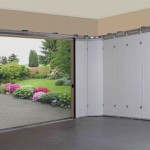Painting a Steel Garage Door to Mimic Wood: A Comprehensive Guide
The aesthetic appeal of a wood garage door is undeniable. However, the maintenance demands and associated costs can be significant. Steel garage doors offer durability and cost-effectiveness, but often lack the visual warmth of wood. Fortunately, it is possible to achieve a wood-like appearance on a steel garage door through careful painting techniques. This article provides a detailed guide on how to transform a steel garage door into a convincing imitation of a natural wood finish.
The process involves several crucial steps, from surface preparation to the application of specialized paints and techniques, resulting in a durable and visually appealing finish. Understanding these steps and applying them correctly is essential for a successful outcome. This article will delve into each of these phases, providing detailed instructions and valuable tips to help homeowners achieve professional-looking results.
Preparation is Paramount: Ensuring a Smooth and Clean Surface
The longevity and aesthetic quality of the faux wood finish depend significantly on the thoroughness of the preparation stage. Insufficient preparation can lead to paint adhesion issues, uneven texture, and ultimately, a less convincing final appearance. The preparation process typically involves cleaning, sanding, and priming the steel surface.
The first step is to thoroughly clean the garage door. Accumulated dirt, grease, and mildew can compromise the adhesion of the paint. Use a mixture of warm water and a mild detergent, such as dish soap, to wash the entire surface of the door. A scrub brush can be helpful for removing stubborn stains. Rinse the door completely with clean water to remove any soap residue. Allow the door to dry completely before proceeding to the next step.
After cleaning, inspect the door for any signs of rust. Even small areas of rust can spread and undermine the paint finish. Use a wire brush or sandpaper to remove any rust completely. For more extensive rust damage, consider using a rust converter, which will chemically neutralize the rust and prevent it from spreading. Follow the manufacturer's instructions for applying the rust converter.
Once rust removal is complete, the next step is sanding. Sanding the surface creates a slightly textured surface that promotes better paint adhesion. Use a fine-grit sandpaper (around 220 grit) to lightly sand the entire surface of the door. This doesn't require removing all the existing paint, but rather roughening it slightly. Pay particular attention to areas where the paint is glossy or smooth. After sanding, wipe down the door with a tack cloth to remove any sanding dust.
The final stage of preparation is priming. Primer serves several important functions: it seals the surface, provides a uniform base for the paint, and improves paint adhesion. Choose a high-quality exterior-grade primer that is specifically designed for use on metal surfaces. Apply the primer evenly using a brush, roller, or sprayer. Follow the manufacturer's instructions regarding drying time before proceeding to the next stage.
Selecting the Right Materials: Choosing Paints and Tools for a Realistic Wood Grain
The choice of paints and tools is crucial for creating a convincing faux wood finish. Selecting high-quality materials and appropriate tools will significantly impact the final appearance and durability of the finished product. The selection process involves considering the type of paint, the base coat color, the graining color, and the necessary tools for applying these coatings.
For the base coat, an exterior-grade acrylic latex paint is generally recommended. Acrylic latex paints are durable, weather-resistant, and relatively easy to work with. Choose a color that will serve as the background for the wood grain. Common choices include tans, browns, and creams. A semi-gloss or satin finish is generally preferred, as it provides a good balance between durability and appearance.
The graining color is the key to creating the wood-like effect. This color should be a darker shade than the base coat, representing the grain of the wood. Consider using a gel stain specifically designed for creating faux wood finishes. Gel stains are thicker than traditional paints, allowing for better control and more defined grain patterns. Alternatively, you can use a heavily tinted glaze, but gel stains are often easier for beginners.
Essential tools for this project include high-quality paintbrushes, rollers, a graining tool, and rags. A high-quality brush will ensure smooth and even application of the base coat. A roller can be used for larger, flat areas to speed up the process. The graining tool is essential for creating the wood grain texture. Several types of graining tools are available, including rocker grainers, combs, and specialized brushes. Experiment with different tools to find the one that best suits your desired wood grain pattern. Finally, clean rags are essential for wiping away excess gel stain and creating variations in the grain.
In addition to these core materials, consider investing in painter's tape for masking off any areas that you don't want to paint, such as windows or trim. Drop cloths are also essential for protecting the surrounding area from paint splatters.
Applying the Faux Wood Grain: Mastering the Technique for a Realistic Look
The application of the faux wood grain is the most challenging and rewarding part of the process. This stage requires patience and practice to achieve a convincing and realistic wood-like appearance. The process involves applying the base coat, applying the graining color, and then manipulating the graining tool to create the desired wood grain pattern.
Begin by applying the base coat evenly to the entire garage door. Use a brush for detailed areas and a roller for larger, flat surfaces. Apply two thin coats of base coat, allowing each coat to dry completely before applying the next. This will ensure proper coverage and adhesion.
Once the base coat is completely dry, it's time to apply the graining color. Work in small sections, typically about 2-3 feet wide, to prevent the gel stain from drying out too quickly. Apply a thin, even layer of gel stain over the base coat. Don't worry about making it perfect at this stage, as you will be manipulating the stain to create the wood grain pattern.
Immediately after applying the gel stain, use the graining tool to create the wood grain texture. The specific technique will vary depending on the type of graining tool you are using. For example, with a rocker grainer, you would rock the tool back and forth across the surface, applying varying amounts of pressure to create different grain patterns. For a wood graining comb, you would drag the comb through the gel stain in a straight line, creating a series of parallel lines. Experiment with different techniques to achieve the desired effect.
After using the graining tool, use a clean rag to wipe away excess gel stain and further refine the grain pattern. This is where you can add variations and imperfections to make the finish look more realistic. For example, you can use a rag to create knots or other natural wood features. Remember to vary the direction and intensity of the wiping to create a more natural look.
Continue working in small sections, overlapping the areas slightly to blend the grain patterns seamlessly. It's important to maintain a consistent direction for the grain pattern, typically running horizontally. For a more realistic look, slightly vary the width and spacing of the grain lines. Regular inspection and stepping back to view the larger composition can help refine the process.
Allow the gel stain to dry completely according to the manufacturer's instructions. Once dry, apply a clear topcoat to protect the finish and enhance its durability. Choose an exterior-grade clear coat with a satin or semi-gloss finish. Apply two thin coats of clear coat, allowing each coat to dry completely before applying the next.
Achieving a convincing faux wood garage door finish requires practice and attention to detail. By following these steps and taking your time, you can transform a plain steel garage door into a beautiful and durable imitation of natural wood.

How To Paint Your Garage Door Look Like Wood Giani Inc

Have Your Garage Door Faux Finished To Simulate Wood Yes Most Of These Photos Are Standard Metal Paint Doors

Create A Faux Wood Garage Door With Gel Stain Crazy Life Littles

How To Paint Your Garage Door Faux Wood

Create A Faux Wood Garage Door With Gel Stain Crazy Life Littles

Metal Garage Painted To Look Like Wood Door Design Doors House

Create A Faux Wood Garage Door With Gel Stain Crazy Life Littles

Faux Garage Doors

How To Paint A Door Look Like Wood 7 Shades Choose From

How To Paint A Door Look Like Wood It S Easier Than You Think Average But Inspired
Related Posts








